
REV/PH Page 1

Internet pages One Two Three Four Five
REVELATIONS
OF PHYSICS
TO
EXPLAIN THE NATURE OF THINGS
By LEONARD VAN ZANTEN
FIRST EDITION
All
rights reserved, including the right of reproduction in whole or in part in
any form.
Copyright
® 1975 by Leonard Van Zanten
Published
by Vantage Press, Inc. 516 West 34th Street, New York, New York 10001
Manufactured
in The United States of America Standard Book Number 533-01624-X
Comments on the jacket by Vantage Press.
If your head is filled with the traditional physics of Newton and Einstein, and if your mind is not open to new ideas and considerations, then this book is not for you. It is not the standard, traditional physics text book, piled high with formulas, equations, and advanced mathematics (with the answer in the back). Neither is it a theoretical, religio-scientific treatise.
Revelations of physics presents a fresh and insightful -- albeit controversial - approach to the topic. It explains the nature of things with words - logic and reasoning -- and simple line drawings in such a fashion as not to obscure the forest for the trees. Dealing with the macroscopic and intangible invisible forces and energies witch make up our universe, and indeed, ourselves, the author demonstrates the simplicity and beauty of the Creator's "Grand Design"
In chapters dealing with atomic structure, electricity, magnetism, motions, material structures, and the use of logic and reason in obtaining a clear understanding of our world, the reader is lead to appreciate the essences of nature and the planned way in which they operate and exist. Additional discussions of "Nature and Insight" and "Foundations of the World," provide sound underpinning of conceptualizing the mechanics of nature.
Revelations of Physics may challenge many of the reader's preconceptions, and may be rejected outright by many scientists, but if read with an open mind, it will prove to be an interesting and thought provoking work.
Chapter 1
NATURE AND INSIGHT
This book, as the second book titled Revelations of Physics, is not a extension of the first, but having completed only the first volume I intended to write I contemplated the fact that the simplicity of the first might not reflect the simplicity I wished it to have, to be able to reach the majority of the people who are neither scientists nor physicists so that they also might share in the gift of this knowledge.
I did what I suppose I had originally in mind to do, which was to define simply and communicate the knowledge and principles of nature as the Lord has granted unto me, without going into any defenses against obsolete, or otherwise contrary theories. The knowledge of nature and its own definition is quite capable on its own to defend and confirm itself. The requirement for me to defend it is really non-existent, yet I will for the sake of the young in this generation.
It is indeed most fitting that, while the Lord rules the knowledge of faith among men, by His scriptures unto us, He should also rule the knowledge as it regards the Creation by His hand in the centuries yet to come. For likewise as men established their own laws first, and then the Lord gave His law to a chosen few by the hand of Moses we have established our theories in natural science after which the Lord reveals their truths by the instrument of a simple person.
For indeed the knowledge hereof, in which it has been granted to me to be a stone of the foundation, will be the subject of natural science in the future generations, together with those persons who were before me which are not many. Since the most of these which we honor now will no longer be known in the centuries to come, their names will be among the forgotten ones.
As a child I was compelled to be educated in a foolish manner, for a man, Calvin, wrote in his days many defenses against the vices opposing truth, and they served their purpose, but only in his time, or in such times, as they might have been expedient. Yet unto this day, men pass on these precepts of defenses upon the children, as were they the doctrine of truth. While other and different vices now have them sick unto death, yet they administer nothing against these poisons. Wherefore then shall one ointment heal him upon whose wound poison is placed?
In the days of my youth I considered these things, and I thought by myself, To what purpose shall it be to teach a great thing by and in defenses of contradictions, which after one or two generations will no longer be applicable? For instead they will have other contradictions to contend with, lest the outset of contradictions becomes our educational purpose rather than to perceive and set forth upon the foundations of the structure itself
Therefore I choose to write the principles of nature without such form of things, and for sake of a current defense come on after it with such defenses as might be expedient. The generations yet to come will read these words and considering them put them into practice since the practice of war will no longer be taught, by the peace which reigns from Jerusalem.
And yet one more thing I had in mind writing this first volume in short composition, to leave out as much detail and technical things as possible, yet not to sacrifice the first basics and general knowledge, to provide insight unto those who would cease reading after the first or second technical illustration, or detail in too much detail. With the first volume itself containing these things makes herewith for a whole. For I know the desires of a difference and they are overpowering upon themselves
By nature we understand the six days of creation, for nature is the substance which we term physical and that which is not physical is a nature above this nature. When we speak of the nature of things, or the nature of man’s work, we speak of the things natural, and the manner in which things usually proceed.
With an oversight, the system of nature is one, and making many subjects, we remain still with the one same subject. Considering nature by values or points of values, nature is in three, and its optimum velocity is point three, and its principle working is by a three point principle. Although we may now know what these three’s are in nature, there is something far greater beyond it which were I to explain these facts I would not be called sane.
The first substance of nature is the substance of nature, the actual physical being. But it is not the first thing to be had, for this nature is the third requirement, for it is a mathematical coordination and value, the very fact to account for all things by an order of in which this physical being may be set forth. And that again upon something which is a second requirement in nature, the displacement, or motion of all things, to move about, and make busy, and perpetuate.
When therefore we form a substance, and set it in motion, commanding it an order of things, together with countless more of the same, there is nature before us in all of its beauty and perfection, endless and endless reaching further than our eye can see, or our hearts can conceive, or our mind penetrate.
For it was a mighty hand and an all wise Lord and Father which stretched forth His hand, and called out its order unto them. Therefore it is so perfect and so endlessly manifold and unperceptive all of which upon so seemingly simple a foundation of three in one. Nature in all of its forces is of one beginning and all of its powers are by the same single fundamental motion that proceeds from it even as all of nature's plants and earth and water, air or flesh are of a single substance by the coordination flowing from this single foundation.
And so the foundations of the earth are hereby revealed as it was foretold that they should become known unto us many centuries ago. Yet it also states that thereupon the days of this world are near an end, that the nations be stripped of their power and might, and their rule be taken from them, for they are found wanton.
Now I quite know what will be said of me, and of this book or anything to follow, and what the end thereof must be. While one of the best thereof is that it is quite an ingeniously working system of nature which appears to coincide with the experiences as we know them in nature. But can we be sure that it is indeed as he has set them forth? For some things are logical, and something's are well known, and others can be substantiated, and then there are things no one has ever seen or measured. And for still others we know not what they are, nor can we obtain satisfaction from him.
As for me however, I know my coming and my going, and the Lord who will confirm me. For by the understanding that He imparted unto me have I written these things, and by no other have I acquired these. There is no flesh on earth by which I could have obtained this and much more, and be there anyone at all which knew them, that the same was declare3d before, let him come forth to be known that we may know from where it is that he was.
Let not the simplicity hereof offend you, for it is so purposed. Beautiful pictures may also be set in crude frames to set apart the artist from the instrument wherewith it was sketched.
As we study nature, behold nature like a picture and its conception as a puzzle which before hand is not known. By the insert of a few pieces therefore think not to know nature, or to behold it, but upon completion one may behold nature for what it is
Chapter 2
THE
ATOMIC STRUCTURE
An atom is a system of moving objects like unto our own solar system having a central core called its nucleus, with a number of smaller particles orbiting about it. The atom also is the Alpha, the beginning of substance by systematic arrangement, for it is here where elements begin just the same as a letter of an alphabet is the beginning of all writing. The names proton and electron for the individual particles of the atom may have bee erroneously given, but nevertheless they serve their purpose.
Men reasoned since the electrons orbit around the nucleus their charge must be opposite of the charge on those particles residing within the nucleus whereby they are able to remain separate of one another. In order to explain the fact that a nucleus filled with only positive particles (protons) stays together they inserted neutral particles also, called neutrons, balancing out the protons. Not that this follows any logic, but let us take item by item to define their nature and their working within the concept of nature
ELECTRONS
The
electron is a subatomic particle. It is made up of many more particles each of
which is in motion within the electron much like the motion of the electron
itself within an atom. It is therefore a particle of particles and a system.
For to move in order is a system, The charge of the electron is both
positive and negative having poles just as any planet or magnet as we shall
come to understand when we explain the nature of a charge itself.
To demonstrate what such an electron may appear to be, Figure 1 shows a circle filled with dots as if all things stood still, but when all things move about we would see nothing more than a haze, for we are not able to follow that movement with our eyes.
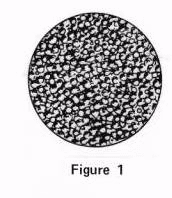
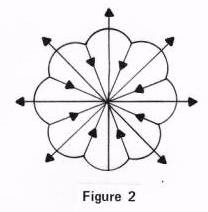
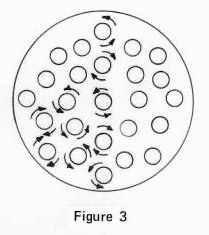
f
we demonstrate it by lines of force we would show it as in Figure
2, with the forces moving in and out of it at equal proportions. While
Figure 3 is to show one of the most
probable motions or arrangements thereof.
There is of course a lot more to the electron however it would confuse
you except we define things by their order.
MICRO
ATOMIC PARTICLES
This is the term for these small particles which speed about within the electron making it a system of things. A micro atomic particle is the building block of matter. It is the smallest particle conceivable. It is not possible to detect them with our devices as they are although we may be able to determine their presence by a relation of things.
The
particles are solid substance, but as to what kind of substance who can know?
For to think of them as some element is missing the point.
An element is a system of particles, while these particles are the real
substance, and not a system, but what we may call the basic form of matter as
substance which requires that it take up space, and not only be a system.
The
Micro atomic particles are named finite dust particles, finite for infinity,
and dust because our Lord said; "Dust you are, and unto dust you will
return."
We
have now covered the basic components of the atom, for the proton, also
consisting of micro-atomic particles, is in that respect not any different
from an electron. There is a lot of difference between the proton and electron
when it comes to forces and energy, but component-wise, the entire atom
consists of but one real particle, the finite dust particle. This particle
then is in motion, and when in motion, we say it has energy, because it can
perform things by virtue of its motion. Therefore we call motion energy.
Let us thus start again from the beginning to define all matter and all nature and energy, from its smallest part unto the largest of systems in the universe.
Matter
and Energy
Matter
is understood as something solid, something which requires space, while energy
is not a component but the motion of solid substance, as it is in motion, by
their system. An atom such as the hydrogen atom, having but very few basic
particles, is made up of finite dust the same as an atom of carbon which has
many particles. There is therefore no difference between the nature of matter
between any element and another. The electron is one
and the same electron in
any and all atoms, even as the proton is the same in any and all atoms, and
the finite dust is the same in all particles, and in atoms, and in whatever is
greater unto it.
What
makes a hydrogen atom, hydrogen, and a carbon atom, carbon, therefore, is only
the aggregate number of particles that reside within one system. For as the
number of particles increases within an atom, the shape and mathematical value
change likewise together with the capacity thereof to perform different
function, etc.
Matter
is its different form by systematic arrangement and mathematical value, just
the same as when we compose numbers and totals by addition and subtraction,
or just the same as we make up a entire language and a dictionary full of
words from but 26 basic letters, which letters are again made up of but one
thing, a line on paper, or a dot. If we place 10 dots one above the other and
look at it from a distance, we read a letter I, and if we place another line
of dots perpendicular across the top of this line, we read a T.
Is there now any difference in the dots of the T from those dots in the
letter I? No, of course not, but only the order in which we place them,
together with the number of dots used make each individual letter.
When
we group letters together we make words, and grouping words together we make
sentences, and putting sentences together we make stories. So also is nature
from one end to the other. And when we say systematic arrangement or
mathematical value, we mean no complex, heartbreaking formulas or equations
such as scientist may use to make things difficult for themselves and for
others, but the simplicity which I conveyed here.
Within
your mind, conceive the finite dust particle orbiting about within a space, together
with many other finite dust particles all of them around a common center,
making up a design, like unto a sphere. This is the electron. From here, this
whole system of moving particles makes still another motion, to orbit around
another common center, the nucleus, as shown in Figure
4.
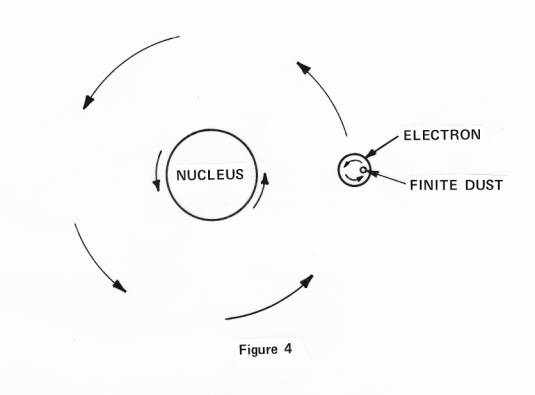

Within
the proton, the finite dust particles also spin about but the proton does not
move in a circle like the electron. Instead it is held in place, together with
a number of other protons, making a core held together by its gravitational
force. This core does rotate however, and in that form of movement, a proton
does move about. (Figure 5) Therefore,
two basic subatomic particles, those at the core, as protons, and those
orbiting around it as electrons, made out of one basic substance called a
particle also, each of which is in motion, and all of it in motion by
combination. Together they make one system called the atom, and up to this
point, nature has its first order of things which we call the basic order of
nature.
For
nature has three magnitudes, or three orders. The first
begins with the finite dust particle, up unto the atom as a single system,
including anything and everything within it, or that is rightly defined as
basic unto the first full system of planetary motion. The second order of
nature which we shall call the general order of nature begins past the atom,
up unto the greatest mass of substance known, all the universe inclusive. The
third order of nature defines no substance nor material formation, but is
strictly a concept of forces.
When
we unite a number of atoms, we call it a molecule, and when we unite
molecules, we call them cells, or units or domains. When we unite cells, we
end up with substances such as our eyes can behold, the flesh of our skin, or
sand or glass or paper or wood. And when we combine a lot of sand and stones
we end up with a mountain, or an entire planet, etc.
At
this point, nature has completed its primary formation, and what is beyond are
secondary formations or multiples of its basic form, because our solar system,
the sun with its planets, is like unto the atom itself, a single system. And
our galaxy is also again a single system except therein entire systems acts as
individual parts. Finally, each galaxy of a billion or so stars acts as a
single part of the system of the universe.
We
are wont to complicate and confuse things by lack of understanding. Knowledge
is therefore not yet wisdom, and while man by himself is unable to enlighten a
simple mind with even the small things, Wisdom does with the greatest of
things in their very simplicity. Or we might say she lays forth a highly
skilled matter in simple terms.
Of
themselves men are wont to restrict the beauty of nature to endless formulas
which they themselves understand not for their truth, yet our Lord is
pleased in teaching the small the beauty upon fundamentals everyone can
understand.
Polarity
When
you look around you at all things which exist before your eyes, and you
realize how all of this is set forth by arrangement of but one basic substance
(and we do realize the very ideal of mathematical co ordinance, to so bring
forth these things in their motions as they are related to one another), then
how shall we suppose that there exists anything else besides this one simple
substance, and the motion thereof? For we require nothing more to bring all
things to existence and to make each part perform its function as required.
Indeed
nothing more is needed, and nothing more does exist within the physical world
of nature, only matter as substance and only motion as energy. But this motion
is most interesting, for by its relation to all other motions, it makes for
everything that is and every force and motion upon the earth or within the
universe is performed by it—a most perfect system by a most perfect and
skilled hand.
It
shall therefore be obvious that anything we may have had in mind, to conceive
something supernatural as a charge, or an electric fluid, is child's play,
since the motion of a particle in certain directions, and at certain
velocities, and within certain relations to other particles in motion, or
entire systems of particles in combinations of motions, shall be the only
manner in which that is borne forth, that which we call a charge, or
electricity.
To
have a north and a south pole is like having a right and a left hand, or like
having one end and the other. And to be positive or to be negative is a
direction of motion, for either we go one direction, or the other. Motion
is motion, and can not be any different in its nature of being. It can only
vary in its direction, or its velocity, or its relation to others.
If
therefore we ask, what is electricity? it is immature to think of it as some
sort of charge, or a different nature of motion from that of motion such as
magnetic forces, or gravity. All such forces as we stated, are brought forth
by various relations of systems, one to another, and their difference in
attraction or repulsion is the manner in which these motions face each other,
or relate to one another.
Let
us take a gyro as in Figure 6 and
let it rotate in front of us, as in position A. so that the direction of the
motion nearest to us travels from right to left, and let us call this to be
positive. Anything therefore that we might place upon the edge of the gyro
here would be thrown out and away towards our left side.
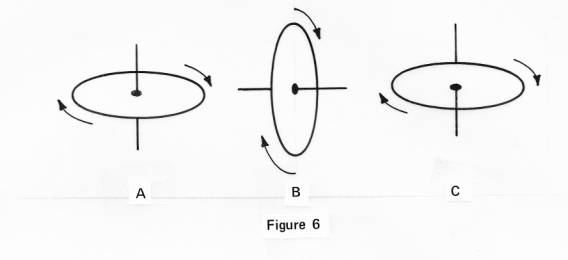
But
on the other side of the same gyro, anything placed upon it would be cast out
to our right side, for also the motion on
the other side is from our left to our right and must be called negative,
since it is exactly opposite to the direction of motion nearest to us. The
gyro acts exactly opposite over its two sides, one from the other, yet is it
one and the same motion, one and the same gyro.
Suppose
then, we tilt the gyro over its edge as shown, to turn it upside down, and we
view it again. We note that the motion of the edge nearest to us is now
turning the opposite direction from before, wherefore we say, that this side
is now negative because the motion is from left to right. The poles of a
magnet, or the charges of a electric current, are of course not merely as
simple as one gyro, the same as the words north and south are not as simple as
A, B, C.

What a north pole or south pole represent
on a simple magnet we can thus demonstrate as in Figure
7, where we represent the magnetic forces upon the bars as motions of direction. Let therefore the
end of the bar where the motion is ingoing, be the negative or south side,
and where the motion is outgoing, let it be the positive or north side.
If
two magnets then face each other with unlike poles, their motions will be in
one the same direction, and motions to one direction unite, or combine, and
draw to each other. Therefore there is attraction. If alike poles face each
other, then their motions are unlike each other and will not combine nor unite
but draw apart, which we call repulsion. Figuratively speaking therefore, we
might say that unlike attract to one another, while alikes repel one another.
But in reality, it is just the other way around, for all of nature demonstrates
to us that every kind seeks its own, and is at rest therewith, while all such
things which are not alike unto each other, do not combine to be attracted.
It
is the difference in one that makes all the difference, and not the
difference of two. Consider but a man and his woman. They are one flesh, yet
also they are two because they are the difference of one, and alike unto each
other because they are of one flesh. They do attract to one another and unite,
while two men or two women are separate entities, and together are not the
difference of one.
That
polarity is merely a direction of motion. That a positive charge, or a
negative side of any bar, or a flow of current, is merely a matter of
establishing a point of view, to define one relation to the other, or to know
a right from a left, is like A B C of the alphabet, and shall by itself not
give us a complete understanding. But we will understand it most perfectly,
and realize it, as simple and as logical as a left and right hand, once we
behold the entire puzzle of nature laid in place piece by piece.
The
Proton
The
proton was so called because men thought it to hold a positive charge only. In
truth however, the proton is as much positive and negative as any magnet is,
since indeed, the proton may be considered a tiny magnet, even as our
electrons are small magnets. A proton is much larger than an electron however,
and contains consequently a much greater number of finite dust particles. The
reason that the proton is larger is found within its functions and place
within the system of things. For example, we can consider a proton to be a
stationary particle in respect to an electron, which speeds around in a
circle. Also being clustered together with a number of other protons, the
overall motions of each proton, aligns in
its directions with those of all the others next to it in quite a critical
fashion to maintain a balance among them.
The
same thing is not true for an electron of course, since it singularly moves
around in a circle, and is relative to other electrons only at a distance.
We
should now like to know just how the relation of all these motions compare
with the atom as a system, to explain exactly how the atom is, what it is, why
there is a core, and how it stays together; to realize why the electron can
not be equal in size to the proton, while unlike protons it does orbit around
to begin with, what made us think electrons to be negative and protons
positive; or why they pull to different poles when passed through a field;
each of which seems common knowledge and yet is not. Because the fundamentals
are not clear we must begin with the A B C
of their fundamentals, in a step-wise procedure, repeating our former steps
occasionally.
Our
next step must be magnetic and electric motion, and it may be best not to
define them beginning at their beginning since the larger systems provide a
much better means to understand them.
Chapter
3
ELECTRICITY
AND MAGNETISM
I
named this chapter by both these names or terms because basically they are one
and the same. Only at the final outcome do we separate them to know the
differences of their single nature. Considering within ourselves how nature is
again but only a single substance in motion, and how motion by its relations
makes for all things. What shall magnetism be if not a name for the relation of
these motions?
Indeed
so it is; a convenient name to say relations of motion.
To say magnetism therefore we are speaking of nature itself for all
that it is, since motion by relation makes it, and magnetism is this relation.
Nature in that sense of the word is by magnetic motion or force, and
that again in no other way than such ways as we make up for language, or
mathematical numbers or arrangements thereof.
ORDERS
The
orders of nature are also defined as the orders of magnetism, for since motion
is the promoter of these orders they should rightly be called by their term of
magnetism. However we require
more distinction, for if we sort of separate nature into its two basic things,
matter and energy, and we wish to define matter specifically, we are dealing
with nature in its material aspect, putting aside the motion or energy aspect.
If we wish to deal specifically with forces and motions of nature we can place
the material aspects aside. The
terms used in the orders thereof are as follows; in a material aspect we say,
the first, second, or third order of nature or magnetism, and when speaking of
energy or force, we should commonly use the terms, basic order, general order,
and overall order.
The
first or basic order contrives the fundamentals of nature. The second or
general order contrives the entire randomness of nature to all of its natural
existence, while the third or overall order is a manifestation over and beyond
the natural balance of nature to produce forces over the common and always
existent natural forces fully contained in the first two orders.
We
must understand terms and references and values in order to follow the order
in which all things take place as we in our discussion go back and forth to
define them by comparison. Therefore let us also speak of values and of
principles.
Values
and Principles.
Numbers
have values and they have meaning. All things can be given a value or meaning,
but we can not give anything a value nor meaning simply because they already
have their meaning and their value established unto them by their Creator.
We can therefore merely repeat those values and meanings. Matter for
example has a value of 6, the number 6 means matter or earth, more precisely,
imperfection, or incompletion, whole the number 7 means perfection, or
completeness and is ascribed unto motion or energy.
Motion
may therefore be represented by a number 7, and matter by a 6.
Aside from this, nature is full of these values and meanings all of
which follow a most perfect harmony that no mathematician has been able to
comprehend let alone define, or that he should be able to define things or
explain their relation. To a mathematician the fact that 3 and 4 makes 1-1/2,
or that a 10 is equal to 8 makes no sense. Here is where the mind of wisdom
only can discern its meaning, or how this computes.
It
is a perfect mathematics that the world has not perceived nor shall it
understand it at any time. The book of Revelation states at one place that the number of
the beast has a number of three sixes, and even though one might think to
understand its meaning now by the things I have said, yet he shall not, but
everyone that has wisdom will understand it.
When
take in mind an atom such as we have drawn in figure 8, with all of its parts
in continuous motion we are unable to state particular motions in a continuous
concept unless we place a line over it establishing unto ourselves motions
and/or points of distinction by which we may have reference.
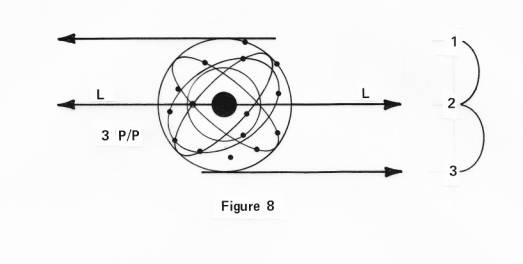
The
line L in Figure 8 being drawn over
the nucleus we should consider as a stationary point of entity of force in
relation to the motions about it, which is one circular motion but has at any
point directly over the center two opposite directions.
Or we could say 180 times two opposite directions, but the number two
is only a multiple of the first and therefore not distinct. Or we could say
there are four directions if we add one on each of the vertical sides, but
they add no distinction to the first two anymore. Therefore three points of
distinction are correct for a reference thereof. There are a host of other
fundamental reasons to substantiate these three points, but for the time being
let us accept them this way.
Consider
Newton's law of equal actions and how each force therefore must be backed by
another equal force. The motion to the right in figure 8 could not present a
show of power having its nucleus alone as a base, for it would push the
nucleus away altogether. But with another equal force to the left and opposite of it
over the nucleus both sides can present a show of power. And while they show their power they remain balanced at all
times and tied to one another controlled by a center, for the two are only the
difference of one.
This
we call the three point principle of nature, or of magnetism.
Other things aside it means that nature by its relations follow s a
principle of distinction in three parts of reference and any other point or
part of reference are merely multiples of the first.
Lines
of force and lines of motion may be imaginary representations of powers that
proceed such as magnetic and electric fields, but they are not as imaginary as
we may think. For if we look at
things through a powerful microscope we find that all things have an order of
structure, and that these structures are particles or systems of particles
coupled to each other making lines without end.
Lines
of motion are therefore very real, for as the electrons of one atom spin about
in a circle, and the electrons of the next atom do the same they do indeed set
up a line of motion in a linear fashion as shown in Figure
9 which is caused by angular motions.
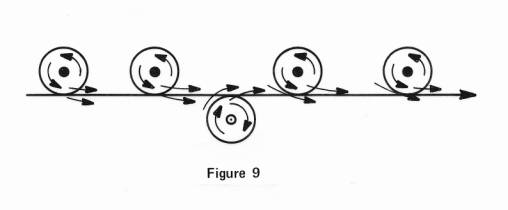
The
reality of motions to conduct their alignment I will explain properly when
after all is said we return again unto the atom.
In
terms of force or motion nature starts out with the intrinsic spin of the
finite particle. This motion by itself in no way represents any ideal of
polarity unto any system because it is the first motion of nature which by
itself does not represent charges nor polarity. Secondly, this finite dust
particle or bits around within the body of the electron, because the space
taken up by all the finite dust particles belonging to the electron, we
consider to be the electron itself or its body. And this motion is rightfully
called velocity since it speeds through space.
These two motions therefore, spin and velocity for the first system in nature to make up one sub atomic particle, and each and every sub atomic particle.
In
the total formation of them, we do now have a polarity, however, because with
many particles moving by and in certain orders and about a common center, an
overall relation of motion, or pattern is exhibited. And since this pattern is
the real motion of real particles, with real power to do things, they do
indeed act with real polarity to any and every other system of the same
motions. As to what direction of motion one will take when confronted by
another depends on just how they are positioned to each other, just as two
magnets do.
When
we consider the gyro we spoke of before, and compare it with the electron, we
find them to be similar. The electron, as a spinning top, exhibits all the
motions and tendencies which a gyro has when it is rotating. But if the gyro
is idle, it is but a dead peace of material, with capacities for nothing.
In
addition to all the motive inclinations of a gyro, an electron is a magnet,
having all the motive inclinations of a magnet. Therefore we must stop and
consider for a moment the enormous capacity of such a tiny electron to have
such capabilities within it, as it were, a complete system, a full engine, to
perform single-handed the functions it is required to.
Suppose
now we look at this system of particles so that the axis is vertical in front
of us. Then the positive and negative sides thereof are at the top and bottom
of the axis, and not at the sides or equatorial range, as we discussed it with
the gyro before.
Because polarities are directions of motion, we do not really give a single circle two different directions, except as it is so in relation to others again. But when such are related it becomes no longer a difference within a single circle, but a difference within a single and yet whole system of circles, and motions with velocity.
Let
us accept for the moment therefore the poles to reside along the axis, to say
that they concentrate towards these ends. For as we know the whole half of
one magnet is really positive or negative, but we point to the ends to place
its polarity. We shall again come back at this, much later, to explain just
how one end is different from the other, by their difference of direction.
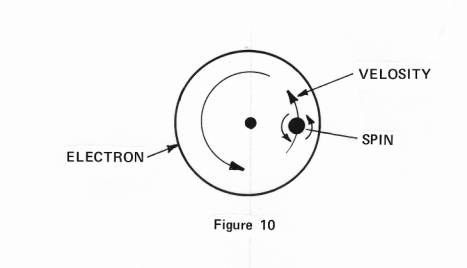
The
proton varies not from the electron in the fact that the finite dust particles
by their motion make it a spinning top, giving unto it all the capabilities of
a gyro, and that of a magnet, by their relations. But since the proton does
not have the motion of velocity which the electron has in orbiting about the
nucleus, it can grow larger. By this I mean it can hold on to many more particles
in unity.
The
very motion however which we are going to describe as the positive and
negative ideal of these particles, creates a deformation into the shape of a
proton, to give it the appearance as it were of two bodies in one, because it
will resemble a sand timer, or a figure eight. The proton has this, because it
is so large compared to a electron, which would have it also, if it were that
large. The velocity of the electron prohibits this.
All
in all, the proton, has intrinsic spin and motion of velocity, the total of
which bears forth a motion of 7000, which is what we shall call the
inclinations of a gyro, or spinning top.
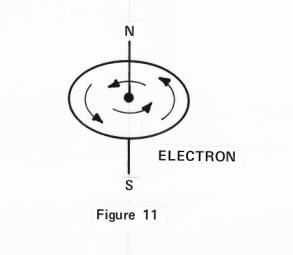
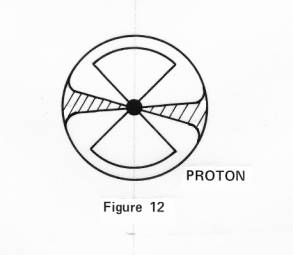
Nature
is already now very much advanced, with all these motions and the host of
possibilities they can pose by their numerous relations to each other, and
yet, we have not even gotten to the atom itself yet. But it shall be our next
step, for when we combine a number of protons, and revolve a number of
electrons around them, we have still another system, the atom itself, with as
many more capabilities to perform things as that by which we multiplied its
basic particles.

The
core, its nucleus, with all its particles having each their own directions of
motion (which is the same as saying polarity), do in addition extend forth a
directive of motion which we might consider as to be upon it as it were the
entire nucleus, but a single system instead. And this force we shall call the
inner magnetic field or force, shown in
Figure 13. It varies little if any from the field of force which is
extended forth by our sun, but it does vary somewhat from the field of force
extended from a planet such as our earth.
The
next force we will call the circle magnetic field or force, for it is nothing
other than the motions of the electrons as they orbit, and in itself, always
turning in a circle, it is of little further use, except were it not for the
fact that they extend forth linear lines of motion as we demonstrated by
Figure 9.
If
we wanted a linear force would we attempt it by creating angular motions? Or
angular forces by creating linear motions? Yes, we would. Consider but the
wheels of a car on the road, and nature does create forces in like manner,
which brings us to the end of the basic order, to begin with the second order
of nature, all as multiples of the first.
General
Motions of Nature
When two or more nuclei connect upon one another by the forces which they extend, they form a bond, or a relation. Just as if a row of men were holding hands making for a line of them, so is a line of force set forth in nature. It is just that simple (see Figure 14). When we consider how each nucleus is a base for motivating particles about it, and thereby acts as a stationary foundation for the same motion, we begin to realize how a structure of matter might actually become quite a rigid formation as one extends upon the other setting forth structures such as we see in crystals.
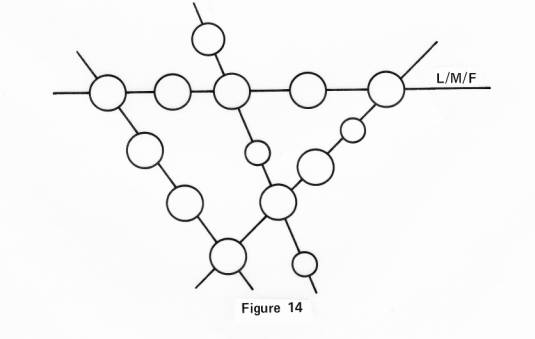
And
this is the formation of substance at large. But we are speaking force-wise
for the moment, therefore we should come to realize these formations of lines,
as stationary forces, have a primary function to bear forth the formation of
matter, and a secondary function, equally important, to serve as a base and
foundation for all motivating forces that wish to proceed upon it.
A
motion such as a radio wave shall not be propagated over these lines of force
because they are not lines which do lend themselves very well for motivation
in continuous fashion, or at any high rate of velocity. But sound is different
since it is the very vibration of the medium itself, and does indeed travel
upon these line magnetic forces, or lines of force as we shall call them. To
conclude this line magnetic forces (L/M/F), we must think of all these lines
of motion in their three-dimensional form.
Unit Magnetic
Force
The unit magnetic lines of force are the
most important, and the most talked about, lines of motion in any subject.
They are the linear lines of motion set forth by the angular velocities of the
electrons everywhere, and abbreviated we shall refer to them as U/M/F.
Although you will find that I most commonly refer to them as the general lines
of motion of nature, or as nature's general motion, or simply, general motion.
With this, the second order of nature has
also been ended, for these two forces, the U/M/F and the L/M/F,
are the multiples of the first order, and
set forth a greater formation. If a line be one inch, or a mile, or whether it
reaches to the ends of the universe, we no longer find a distinction that
should call for a new magnitude, except for the third order, being a magnitude
over it.
If I had said unto you that electricity is
motion, it would have meant little or nothing to you, and had I said that
magnetism is alignment of motion, or the relation by which motion performs the
acts we observe, neither of these would by that reveal the nature of them.
What would one therefore expect me to answer, when I am asked, "What is
electricity?" for he might just as well have asked, "What is all of
nature?" And thus I shall needs, have to fully educate him in the
principles of nature all in all.
To this point we have covered the entire realm of nature as it concerns its natural motions, and its form, yet in all of it, where did we see electricity, or a electric charge? Or a magnetic force? The answer is, we saw it nowhere at all, and yet we saw it everywhere, because a magnetic force is only to behold one motion, or one system of motion, at both ends simultaneously and see a direction at one side, as the opposite of the other. For as they are real, they perform real acts, and at the directions such as we saw them, which anyone of us can prove to himself a million times over, with a host of experimental proofs that are so simple I shall not mention them here.
When we consider the electron and its
motion in reference to a field of motion, such as demonstrated in Figure
15, to thereby determine what type of charge it holds, we shall quite
deceive ourselves. The electron is not about to give its nature away by such
crude attempts to probe its nature. It shall perform in no other way than that
which is determined by the angle of position of the electron in relation with
the motion of the field in its direction thereof, which can be quite a number
of ways, but essentially three ways, following the same principle of nature
that everything else in nature follows.
The idea is that if the electron is pulled
towards the north pole of the field, we say it is of negative charge, not
realizing that it could just as well have been pulled to the south pole, or
gone right through. And even though the precise manifestations are a little
more involved than that which I have drawn, the principle is the same. Let us
suppose the electron as a spinning top at X to pass between the poles, and it
is deflected towards the north pole.
Then let us start all over again, and turn
the electron around first so its top is now under, and consequently all its
motions are now reversed in respect to those motions of the field. Therefore
in passing it through the field again, it will instead be deflected to the
south pole. And lastly let us position the electron in such a manner that its
motions will act with equal opposition or attraction to both poles, and pass
it through, and it will pass completely on through as if it were a totally
neutral particle. Although a truly neutral particle should not be able to
exist, or else live in defiance of all laws of nature.
Where now did we see electricity? We saw
three types of motion, and all three of the basic inhibitions of electricity.
Should it then not become evident unto you that electricity is really nothing
more than acts of motion as they are born forth by the difference in the
positions and directions of things?
When we turn a gyro, and suspend it at
right angles on one end of its axis, it will turn to one direction around in a
circle. If we switch to the other end of the axis, it will turn in the
opposite direction, and note that a motion of 7000 of our gyro is the same as
a magnetic formation of motion, yet the principle in direction and polarity
remains the same however.
More on the nature of electricity and magnetic force, we should cover under their final headings of directional magnetic force, for regular magnets and rotational magnetic force, for electrical currents, after which again we intend returning to the finer points of the fundamentals.